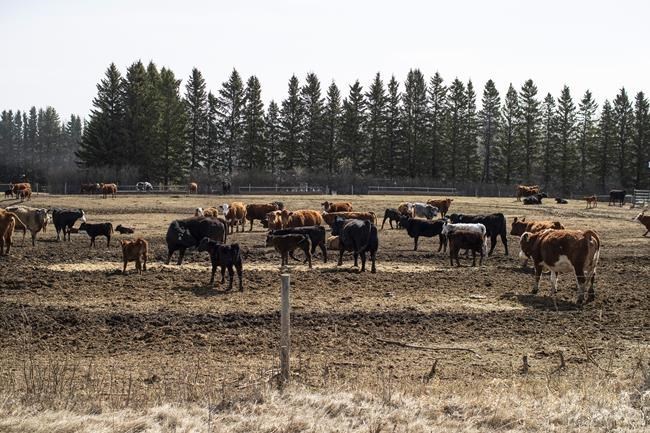An uptick in drought and other extreme weather events has beef farmers in the U.S. and Canada thinning their herds in near-record numbers, which could lead to supply problems in the beef industry over the longer term, industry experts say.
Farmers will increasingly struggle with profitability amid the unpredictable seasons as climate change makes drought, flooding and wildfires more common, they say.
For the past few years, dry conditions and droughts in both countries have prompted farmers to reduce their herd sizes by sending more cattle to slaughter, which has resulted in increased production of beef products, said Desmond Sobool, principal economist with Farm Credit Canada.
Sobool said while this would normally drive cattle prices down, inflation and high demand mean prices are remaining elevated -- and if there’s less supply in the future, that will drive prices up further, which could affect consumer prices as well.
First there was a drought in Canada in 2021, which meant pastures were reduced and farmers had to buy more expensive feed from the U.S., sending costs higher, said Sobool.
That year, Canadian farmers sold thousands of extra cattle in the fall to make up for a shortage in feed due to the impacts of extreme weather, said Stuart Smyth, associate professor in the College of Agriculture and Bioresources at the University of Saskatchewan.
“People … just had to take a huge hit that year,” he said.
When Canada runs low on corn or feed it imports from the U.S., and it did so in large numbers that year, said Dennis Laycraft, executive vice-president of the Canadian Cattle Association. But importing feed can’t always solve the problem on its own.
“Cattle producers are used to dealing with extremes in weather,” said Laycraft. “Unfortunately, when you get multiple years in a row, that's where you start to run out of the feed inventories. And that forces you into more difficult decisions in terms of reducing cattle numbers.”
If the U.S. runs into the same problem, it imports from Canada, he added.
The spring of 2022 was dry, in some areas just as bad as 2021, and farmers kept selling, Smyth said.
Now, there’s a drought in the U.S., and farmers there are facing the same problems, Sobool said.
More than two-thirds of the U.S. cattle herd is in an area affected by drought, according to the U.S. Department of Agriculture and Farm Credit Canada, leading to the largest contraction of the North American cattle herd in a decade.
In fact, U.S. farmers have contracted their herds three years in a row, for a variety of reasons including the drought, said Sobool. This has resulted in the lowest cow herd on record, he said.
While this means more beef is being produced in the short term in both Canada and the U.S., it means supply will eventually go down as herds get smaller, and farmers will send fewer cattle to slaughter while they try to rebuild their herds, he explained.
However, while it’s normal for production to fluctuate from year to year, this time something is different, said Sobool.
Normally when farmers reduce their herds and beef production goes up, prices for cattle go down, which in turn can soften prices along the supply chain.
But because of inflation and continued high demand for beef, farmers are still seeing elevated prices for their cattle, further incentivizing them to reduce their herds, said Sobool.
“It's not pushing down those prices like you'd normally see,” he said.
That’s likely to remain the case, and could affect prices along the supply chain all the way to retail, he said.
Since farmers can only contract their herds so much, eventually they will need to sell fewer cattle and rebuild the herd, which means less production in the short term -- and that normally pushes cattle prices higher, said Sobool.
Meanwhile, extreme weather events are becoming more and more common. If Canada and the U.S. face more droughts in the coming months and years, farmers may struggle further, he said.
“It would be tough for the sector, that’s for sure,” he said.
Smyth said technology will be key to help farmers adapt to the unpredictability of extreme weather, but that requires investment from the government.
Climate change has increased the likelihood of some types of extreme weather across the country, including wildfires and flooding, while drought soil moisture deficits in the Prairies and British Columbia are expected to become more frequent and intense as time progresses, according to Environment Canada.
Though nothing is set in stone, models show this year should be closer to normal weather-wise, said Laycraft, and he expects beef production levels to be more level.
The Canadian Cattle Association is looking into ways to better help farmers mitigate the risk of extreme weather, such as different kinds of insurance, said Laycraft. As well, technological improvements and recent shifts toward more regenerative styles of agriculture have helped the industry be more resilient, he said: for example, an increase in no-till agriculture has helped the land retain more water.
Over the longer term, the increased uncertainty will weigh on the industry, which Sobool and Smyth said could contract as it gets harder for producers to maintain profitability and some may leave the industry.
“The weather has a huge impact on feed and feed availability and water,” Sobool said.
“You can’t lose money for that many years and still be a viable operation.”
This report by The Canadian Press was first published Feb. 20, 2023.
Rosa Saba, The Canadian Press




